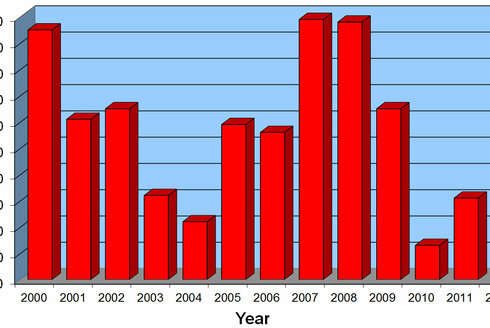General

Based on the 1992—1997 data from the Austrian Lightning Location System ALDIS we performed a systematic analysis to reveal spots of high flash density in Austria.
One of the sites with an extraordinary high flash rate was at "Gaisberg", a mountain near the city of Salzburg. We are assuming that most of the localized flashes actually did hit the radio tower at the top of the mountain. This was also confirmed by the local staff.
Similar numbers of increased high flash rates were observed in Austria at some other mountain tops with radio towers, like Dobratsch and Kitzbühler Horn.
Considering some other aspects as e.g. the accessibility of the site during the entire year, Gaisberg tower was selected for the installation of equipment to perform lightning research on natural lightning.
Besides research on triggered lightning — as done for several years at Camp Blanding in Florida — measurements on lightning flashes to elevated objects are the only way to collect information about the lightning current waveform of natural lightning directly. There are only very few sites worldwide, where direct lighting is measured:
- CN Tower in Toronto, Canada, 550 m
- Chimney in Japan (Fukui), 200 m
- Säntis Tower in Switzerland, 124 m
- Experimental tower in Brazil, Morro do Cachimbo, 60 m
Research Objectives
One of the main goals of the lightning research activities at Gaisberg Tower is applying today's measurement technology for the evaluation of the main lightning current parameters such as
- lightning peak current,
- charge transfer per stroke and per flash,
- current derivative (di/dt).
On the other hand the collected data at Gaisberg Tower provides a unique possibility to validate the performance of the Austrian lightning location system ALDIS. Time, striking point and peak current of the flashes to the tower are well known and we can compare them with the data provided by ALDIS. This allows to validate the most interesting data quality criteria of a lightning location system, as
- detection efficiency
- location accuracy
- peak current estimate accuracy
- classification of CG versus CC lightning

Peak Current
A direct comparison of the peak current distribution provided by ALDIS and by CIGRE and IEEE, respectively, exhibits significant differences. The median of about 13 kA for the ALDIS data is only about 50 % of the median of the CIGRE-distribution with 30 kA.
A main goal of the project is therefore the validation of peak current estimates provided by ALDIS by doing a case by case comparison of the directly measured peak current at the tower top and the corresponding ALDIS peak current estimate.
In upward initiated lightning from a tall tower, there is no first stroke as in any downward (cloud-to-ground) lightning. In upward lightning only subsequent return strokes exist, which follow the so called initial continuing current phase. At Gaisberg Tower up to now almost all discharges have been initiated upward and therefore validation of the peak current estimate for first strokes is still an open issue.

Number of flashes to the tower
The first lightning strike was recorded on September 17, 1998. Until the end of December 2012 about 800 events were recorded. The number from year to year is subject to large fluctuations.
Based on the lightning current records, the vast majority of registered discharges could be identified as upward initiated flashes, which is typical of elevated towers on mountains. The majority of discharges has a negative polarity. Interestingly, some of the current waveforms are also bipolar, a phenomenon that has been observed also in rocket-triggered lightning. Detailed evaluations of the individual groups of lightning discharges on Gaisberg Tower (negative, positive and bipolar lightning) can be found in various publications.